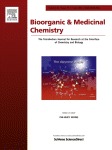Influence of ligand denticity on the properties of novel 99mTc(I)–carbonyl complexes. Application to the development of radiopharmaceuticals for imaging hypoxic tissue
Dublin Core
Título
Tema
Abstract
An important issue in the development of metal-based radiopharmaceuticals is the selection of the labelling strategy in order to couple the metal to the pharmacophore without losing the biological activity. With the aim to evaluate the correlation between ligand denticity and biological behaviour of the corresponding 99mTc complexes, we designed a tridentate and a bidentate 5-nitroimidazole derivatives suitable for 99mTc(I) tricarbonyl complexation and with potential use as radiopharmaceuticals towards hypoxic tissue diagnosis. Ligands were synthesized using metronidazol, a pharmaceutical containing the bioreductive pharmacophore as starting material. The chelating units were connected to the pharmacophore using the click reaction of Huisgen. Both 99mTc complexes were obtained in high yield and were hydrophilic and stable in labelling milieu. The complex obtained from the tridentate ligand exhibited high stability in human plasma, low protein binding and a favourable biodistribution characterized by low blood and liver uptake, fast elimination and negligible uptake in other organs or tissues. Selective uptake and retention in tumour together with favourable tumour/muscle ratio makes this 99mTc-complex a promising candidate for further evaluation as potential hypoxia imaging agent in tumours. The bidentate ligand, on the other hand, yielded a less stable 99mTc-complex that experimented hydrolysis in vitro and decomposition in human plasma and showed high protein binding, high blood and liver uptake and moderate excretion. Although selective uptake and retention in tumour was also observed physicochemical and biological behaviour are inadequate for in vivo use, demonstrating that denticity of the ligand is particularly important and that tridentate ligands are preferable in order to prepare 99mTc-tricarbonyl complexes for Nuclear Medicine imaging
Fuente
Editor
Fecha
Derechos
Información sobre Derechos de Autor
(Por favor lea este aviso antes de abrir los documentos u objetos)
La legislación uruguaya protege el derecho de autor sobre toda creación literaria, científica o artística, tanto en lo que tiene que ver con sus derechos morales, como en lo referente a los derechos patrimoniales con sujeción a lo establecido por el derecho común y las siguientes leyes
(LEY 9.739 DE 17 DE DICIEMBRE DE 1937 SOBRE PROPIEDAD LITERARIA Y ARTISTICA CON LAS MODIFICACIONES INTRODUCIDAS POR LA LEY DE DERECHO DE AUTOR Y DERECHOS CONEXOS No. 17.616 DE 10 DE ENERO DE 2003, LEY 17.805 DE 26 DE AGOSTO DE 2004, LEY 18.046 DE 24 DE OCTUBRE DE 2006 LEY 18.046 DE 24 DE OCTUBRE DE 2006)
ADVERTENCIA - La consulta de este documento queda condicionada a la aceptación de las siguientes condiciones de uso: Este documento es únicamente para usos privados enmarcados en actividades de investigación y docencia. No se autoriza su reproducción con fines de lucro. Esta reserva de derechos afecta tanto los datos del documento como a sus contenidos. En la utilización o cita de partes debe indicarse el nombre de la persona autora.
Formato
Idioma
Tipo
Identificador
Cobertura
Document Item Type Metadata
Original Format
- Fecha de agregación
- August 10, 2012
- Colección
- Bibliografía Nacional Química
- Tipo de Elemento
- Document
- Etiquetas
- Radiofármacos, Tecnecio, Tejido hipóxico
- Citación
- Fernández, Soledad, “Influence of ligand denticity on the properties of novel 99mTc(I)–carbonyl complexes. Application to the development of radiopharmaceuticals for imaging hypoxic tissue,” RIQUIM - Repositorio Institucional de la Facultad de Química - UdelaR, accessed July 26, 2024, https://riquim.fq.edu.uy/items/show/58.
- Archivos

